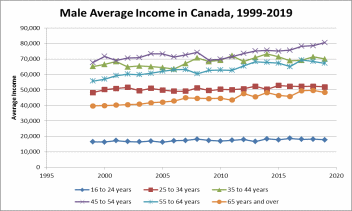The average income for males in Canada can be explored by classifying individuals based on age. The chart below represents the mean income computed for each sub-division for males in Canada for the years spanning from 1999-2019 (Statistics Canada). It is a graph that maps the trend of income levels and the underlying differences between one age group and another. The purpose of this chart is, therefore, to find out how the various groupings compare to each other in terms of income levels and the impact of time on average income.

At the top of the graph is the line representing the average income for the group 45-54 years. The chart indicates that members of the population under this sub-category had been sustaining the highest levels of income for 20 years until 2019. Below this group are members in the category 35-44 and this group has maintained the second position throughout. At number three is the class with members aged between 55 and 64 years. These males have also managed to maintain this ranking over the 20 years. The classification 25-34 years represents male members who are fourth in terms of average income levels. The second last position has been taken by the category of 65 years and over while the least earning group is 16-24 years.
There seem to be three clusters represented by chart lines with very common and lose attributes. The top grouping is composed of three top-earning age groups, followed by another cluster of the next two groups while the age group 16-24 years stands as an outlier. It appears that between 16 and 24 years, income levels have not stabilized. It is relatively commendable that this age group has members who are already earning even though their average income cannot be compared with the rest of the teams. At this age, the young people do not have adequate working skills or experience and this fact reflects in their average income. It is also possible that some of them are not working at all and are at various levels in their education or are still searching for employment.
The age groups 25-34 and 65 and over form a relatively low-earning cluster compared to the collection of groups above. The low average income can be viewed as the income of transition from the respective preceding age groups. For instance, the 25-34 category has members transitioning from the 16-24 years grouping. The level of working experience and skills for the joining members is still low and it could be a determining factor that ultimately lowers the average income.
At 65 years and above, members are changing from active employment to other sources of income like businesses. In this category, some of the members might not have other strong sources of income and it explains the decrease in average income compared to the preceding category. The top three chart lines as presented in the graph suggest that the prime working years for males in Canada range between 35 to 64 years. Members in this category are experienced workers with higher bargaining powers at their workplaces. At the age of 45-54, males in the Canadian workforce experience the best income levels as presented in the chart.
The foregoing chart illustrates three clusters of income levels for the Canadian male population. The groupings can be presented as low, middle, and high-income earning categories. The chart indicates the impact of transition from one setting to the next on the average income for the Canadian male workforce. The graph provides an elaborate analysis of levels of income at different age groups and tells the story of the Canadian male workforce from 1999 to 2019.
Reference
Statistics Canada. (2021). Table 11-10-0239-01 Income of individuals by age group, sex, and income source, Canada, provinces, and selected census metropolitan areas. Web.